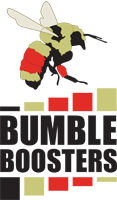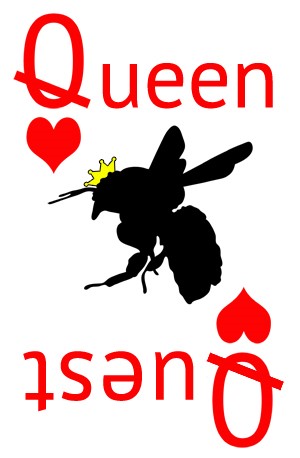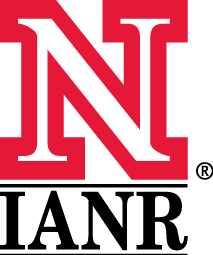Nesting Block Information
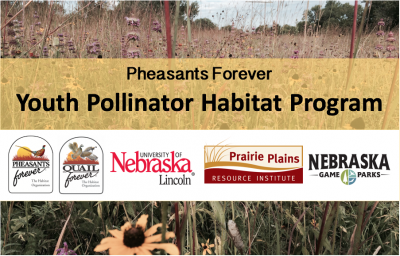
Main Page Blue Vane Trap Information Public Monitoring with iNaturalist FAQs
Nesting blocks attract solitary bees and wasps by providing a nesting habitat for these insects. The nesting blocks put out by our citizen scientists are helping us understand what insects are utilizing the habitat as well as what diameter hole sizes they prefer. For this study, each nesting block has holes drilled with a specified diameter and depth. A nesting block bundle has five nesting blocks, each with different hole diameters.

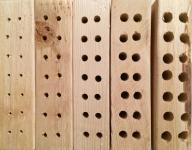
Nesting block Nesting Block Bundle
There are some types of bees that are known to use artificial nesting blocks. Below are some pollinators that might be observed. There are many species within each of these groups – this study will help us determine which ones are found throughout Nebraska. Much can be ascertained about the inhabitants of a nesting block simply by observing insects that visit and examining the materials used when nests are constructed.
Leafcutter bees are black with white stripes on their bodies. They will use pieces of leaves to build their nests.
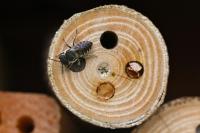

Carder bees may look wasp-like in appearance. They are not very furry and are colored with white, yellow and black. They collect plant fibers to build their nests. You may notice a cotton-like substance at the ends of a carder bee nest holes.
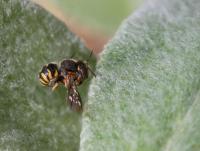
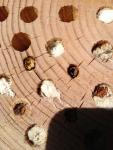
Mason bees can be metallic blue in color. Some species are furry and brown. You may notice mud plugs at the end of mason bee nest holes.
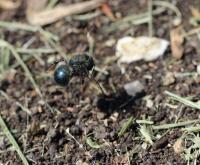
Cellophane bees are very small. They are not furry and are black with yellow coloring on their legs and face. You may notice a cellophane-like material at the ends of cellophane bee nest holes.
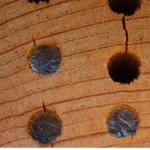
There are solitary wasps that will use nest blocks. It you notice grass sticking out of a nest hole, it indicates that a grass-carrying wasp built a nest within.
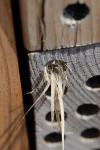
Based on the information above, how many different kinds of bees have constructed nests in the image below?
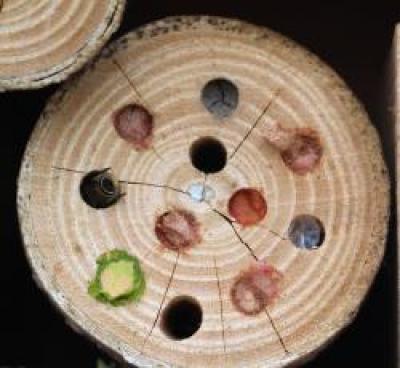
Citizen Scientist Protocol
When to Set Up Your Nesting Block Bundles
Your nesting block bundles will be active for a total of 6 months (April to September)
- Place nesting block bundle #1 on April 1st and pick up on May 31st.
- Place nesting block bundle #2 June 1st, and pick up July 31st.
- Place nesting block bundle #3 August 1st, and pick up September 30th.
Setting Up Your Nesting Block Bundle
- Place the Nesting Block Stand (4”X4”x4’ with platform, provided) in your plot.
-
Try to place the stand at least 20 feet into the plot.
- Sink the stand at least 1 foot into the ground, so it is secure.
- Try to face the front of the stand south/southeast so nest entrances will be better warmed by the sun.
- Make a nesting block bundle with one of each nesting block (provided):
- 1/8” - 3/16” - 1/4” - 5/16” - 3/8”.
- Blocks should be placed vertically and face the same direction. Bind the individual blocks together with the short, white zip tie (provided).
- Place the nesting block bundle on the stand. Use the longer cream-colored zip tie (provided) to secure the block to the stand.
- Once it is set up, take a picture of your nesting block.
- Place one nesting block bundle on the stand April 1, and remove it from the field May 31st. Remove the nesting block bundle from the stand by cutting the long zip tie that secures it to the stand.
- Fill in your data sheet when you place the block and when you pick it up. This data, along with photos, can be submitted online at http://go.unl.edu/y4yp.
- Separate the five nesting blocks from the bundle by cutting the short zip tie.
- Place each nesting block in its own gallon zip lock bag (provided). Make sure each bag is sealed. Remember – we’re interested in which pollinators use which hole sizes.
- Place the 5 bagged nesting blocks into a priority mailing box (provided) with your completed data sheet (unless submitting online). If you have blue vane trap samples, include those as well.
- Store the nesting blocks with the nest holes facing upwards until you are ready to ship. This orientation is important – the bees inside must face the entrance so that they can emerge successfully.
- Use the postage paid mailing label (provided) and ship to:
Doug Golick, PF/QF Pollinator Research
103 Entomology Hall,
Lincoln, NE 68583-0816
- Repeat steps 2-11 for nesting block bundles #2 and #3.
